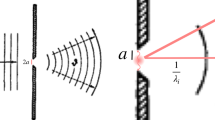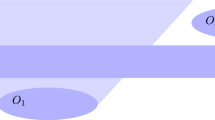Abstract
Using the history projection operator (HPO) approach to consistent histories we rederive Unruh's result that an observer constantly accelerating through the Minkowski vacuum appears to be immersed in a thermal bath. We show that propositions about any symmetry of a system always form a consistent set and that the probabilities associated with such propositions are decided by their value in the initial state. We use this fact to postulate a condition on the decoherence functional in the HPO setup. Finally we show that the Unruh effect arises from the fact that the initial density matrix corresponding to the inertial vacuum can be written as a thermal density matrix in the Fock basis associated with the accelerating observer.
Similar content being viewed by others
REFERENCES
Anastopoulos, C. (2000). Quantum fields in nonstatic background: A histories perspective. Journal of Mathematical Physics 41, 617. gr-qc/9903026.
Fulling, S. (1973). Nonuniqueness of canonical field quantization in riemannian space–time Physical Review D 7, 2850.
Gell-Mann, M. and Hartle, J. (1990). Quantum mechanics in the light of quantum cosmology. In Complexity, Entropy, and the Physics of Information, SFI Studies in the Science of Complexity, Vol. VIII, W. Zurek, ed. Addison-Wesley, Reading, pp. 425–458.
Griffiths, R. B. (1984). Consistent histories and the interpretation of quantum mechanics. Journal of Statistical Physics 36, 219–272.
Guichardet, A. (1972). Symmetric hilbert spaces and related topics. Lecture notes in mathematics Vol. 261, Springer-Verlag, Berlin.
Isham, C. J. (1994). Quantum logic and the histories approach to quantum theory. Journal of Mathematical Physics 35, 2157. gr-qc/9308006.
Isham, C. J., Linden, N., and Schreckenberg, S. (1994). The classification of decoherence functionals: An analogue of Gleason's Theorem. Journal of Mathematical Physics 35, 6360. gr-qc/9406015.
Isham, C. J. and Linden, N. (1995). Continuous histories and the history group in generalised quantum theory. Journal of Mathematical Physics 36, 5392. gr-qc/9503063.
Isham, C. J., Linden, N., Savvidou, K., and Schreckenberg, S. (1998). Continuous time and consistent histories. Journal of Mathematical Physics 37, 2261. quant-ph/9711031.
Omnes, R. (1988). Logical reformulation of quantum mechanics. I. Foundations. Journal of Statistical Physics 53, 893–932.
Savvidou, K. (1999). The action operator in continuous time histories. Journal of Mathematical Physics 40, 5657.
Unruh, W. (1976). Notes on black hole evaporation. Physical Review D 14, 870.
Unruh, W. and Wald, R. (1984). What happens when an accelerating observer detects a Rindler particle. Physical Review D 29, 1047.
Author information
Authors and Affiliations
Rights and permissions
About this article
Cite this article
Noltingk, D. Consistent Histories Approach to the Unruh Effect. International Journal of Theoretical Physics 40, 1411–1426 (2001). https://doi.org/10.1023/A:1017501410519
Issue Date:
DOI: https://doi.org/10.1023/A:1017501410519




